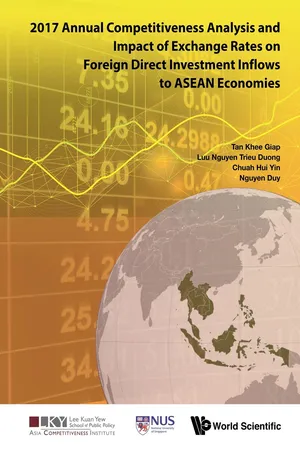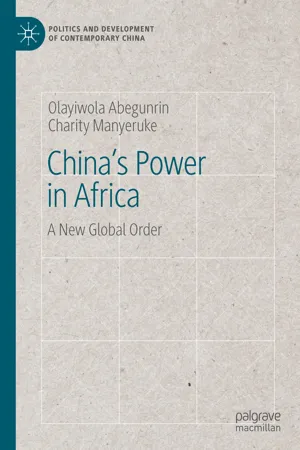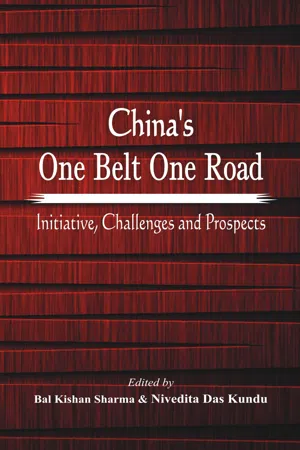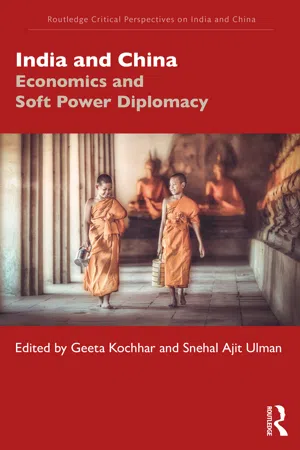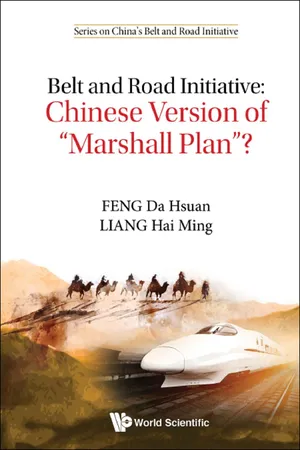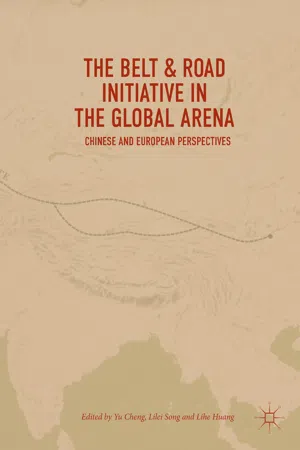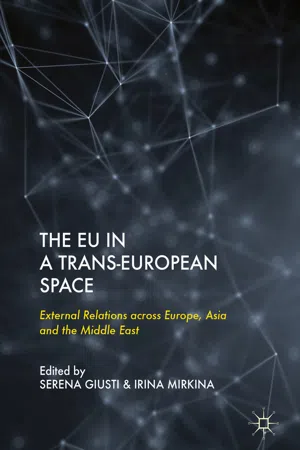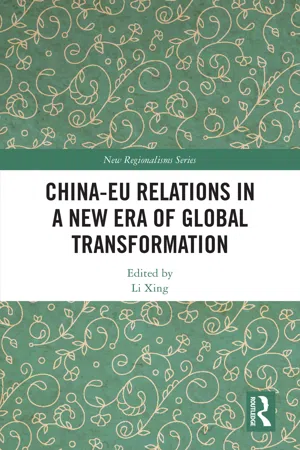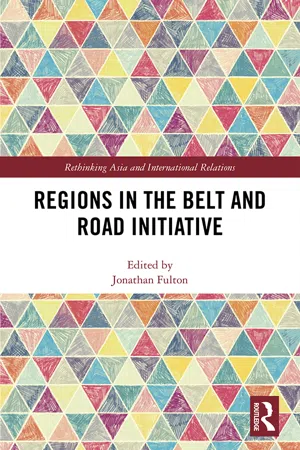Geography
One Belt One Road
"One Belt One Road" is a Chinese initiative aimed at enhancing connectivity and cooperation among countries in Asia, Africa, and Europe. It consists of the Silk Road Economic Belt and the 21st Century Maritime Silk Road, focusing on infrastructure development, trade, and investment. The initiative seeks to promote economic integration and cultural exchange along the ancient trade routes.
Written by Perlego with AI-assistance
Related key terms
Related key terms
1 of 4
Related key terms
1 of 3
11 Key excerpts on "One Belt One Road"
- Khee Giap Tan, Trieu Duong Luu Nguyen;Hui Yin Chuah(Authors)
- 2018(Publication Date)
- WSPC(Publisher)
Chapter 5One Belt One Road Initiative: Global and Geo-economic Perspectives5.1Introductory NotesThe origin of the One Belt One Road (OBOR) initiative can be traced back to the speech by President Xi Jinping when the idea of building an economic belt along the ancient Silk Route was proposed during his state visit to Kazakhstan in September 2013. The idea was reiterated a month later when President Xi visited Indonesia and put forward another initiative of 21st Century Maritime Silk Road.1 The proposal which was officially termed OBOR or the Belt and Road Initiative (BRI) took off rapidly with concrete steps being taken subsequently. The commitment of the Chinese government in promoting the initiative is also reflected in the enshrinement of the initiative in the party’s constitution during the 19th National Congress of the Chinese Communist Party.2Inspired by the ancient Silk Route which connected the East and the West and allowed the exchange of goods, culture and knowledge, OBOR will be covering the continents of Africa, Asia and Europe, which account for more than 60 percent of world population and 30 percent of world GDP.3 It took almost two years since President Xi’s 2013 speech for an action plan detailing the structure and mechanism of OBOR to be announced at the Boao Forum in March 2015. The multilateral cooperation which laid out five cooperation priorities, namely (i) Policy coordination; (ii) Facilities connectivity; (iii) Unimpeded trade; (iv) Financial integration; and (v) People-to-people bonds,4 aim to go beyond building economic synergy and incorporates the importance of sharing mutual social, political and cultural interests. These are to be achieved through connectivity enhancement.The main feature of OBOR which envisions a common prosperity future augmented by an efficient and integrated network of land, sea and air connectivity has distinguished the initiative from other forms of multilateral cooperation. While some sceptics view this as China’s move to exert its influence on the international scene, the formulation of OBOR is well received as illustrated in the establishment of Asian Infrastructure Investment Bank (AIIB), an initiative in line with OBOR which has received endorsement from 57 founding members.5 Indeed, OBOR has come in a timely manner amid great infrastructure investment needs in Asia. For instance, the Asian Development Bank Institute (ADBI) has estimated that the overall infrastructure financing need for Asia from 2010 to 2020 amount to approximately 8 trillion US dollars, or an average of 730 million US dollars annually.6- eBook - ePub
China's Power in Africa
A New Global Order
- Olayiwola Abegunrin, Charity Manyeruke(Authors)
- 2019(Publication Date)
- Palgrave Macmillan(Publisher)
Ethiopia are also of strategic importance to the success of China’s latest economic undertaking.OBOR Initiative in Perspective
The One Belt One Road (OBOR) initiative championed by China’s President Xi Jinping is an extensive long-term infrastructure initiative, which has been seen by many as the rebirth of the original Silk Road trading routes. The initiative comprises two core components. The first component is the Economic land belt, which links countries by road along the ancient Silk Road through Central Asia, the Middle East , West Africa , and Europe. The second component of the belt is the Maritime Road, which links countries by sea along the Eastern coast of Africa pushing up through the Suez Canal into the Mediterranean Sea. The World Bank states that China has entered into cooperation agreements with 71 countries and international organizations, which, China included, make up sixty-five percent of the world’s population and about thirty-four percent of the world’s GDP .10 The total population of all countries connected through this initiative is around 4.4 billion, covering sixty-five percent of the world’s inhabitants and accounts for nearly one third of worldwide GDP and about twenty-nine percent of the global economy ,11 The OBOR initiative could result in investment worth about $6 trillion being invested in the coming years and having the effect of reshaping global trade. The introduction of the OBOR initiative in 2013 has further put Africa on China’s radar and has resulted in a special relationship between the two.12 Ehizuelen and Abdi note that the OBOR initiative represents the linchpin of China’s foreign policy as envisioned by its leadership.13 The initiative aims to set a new path for nations of Asia, Oceania, Europe, and Africa to promote improved growth and human development through infrastructural linkages, improved trade, and investment - eBook - ePub
Chinas One Belt One Road
Initiative, Challenges and Prospects
- B K Sharma, Dr. Nivedita Das Kundu, B K Sharma, Nivedita Das Kundu(Authors)
- 2016(Publication Date)
- VIJ Books (India) Pty Ltd(Publisher)
Section IOne Belt One Road: China’s Perspective1Understanding the One Belt One Road Initiative: China's PerspectiveYang MinghongOver the past 2000 years, the Silk Road has been expanding on the world map, telling inspiring stories of people to people exchange and mutual benefits among the countries. Recently, the revival of the great Silk Road spirit has become a guiding post for the world political and economic fields with the peaceful rise of China. From China’s perspective, there are several clarifications that need to be addressed. When discuss about the “Belt and Road Initiative”, many think tanks and scholars relate it to the concept of “economic corridor”. It is necessary to introduce and elaborate relevant facts in accordance with the official and authoritative document Vision and Actions on Jointly Building Silk Road Economic Belt and 21st-Century Maritime Silk Road (hereafter referred to as the Vision and Actions).OBOR is an Initiative or strategy?After the proposal of the ‘Belt and Road’ Initiative, many overseas media and think tanks refer to it as a “strategy”. The use of the word “strategy” suggests that China wants to pursue the benefits of the Belt and Road Initiative exclusively from the perspective of its own national interests and it is even a game strategy targeting certain countries. - Andrew W.H. Ip, Lianne K.W. Lam, Andrew W.H. Ip, Lianne K.W. Lam(Authors)
- 2023(Publication Date)
- CRC Press(Publisher)
Chinese President Xi Jinping’s Belt and Road Initiative (BRI), also known as One Belt, One Road (OBOR), consists of the Silk Road Economic Belt (SREB) and the 21st century Maritime Silk Road (Ming, 2018 February 15). As well as its neighbors in the region, it hopes to establish connections and collaborations, trade, create infrastructure, and make investments throughout the world (Swaine, 2015). To the benefit of Chinese economic and soft power, this strategy will be implemented. According to the BRI, China’s plan to fund and build infrastructure across Eurasia is now known as the BRI. Chinese President Xi Jinping pledged $113 billion in the Belt & Road summit, which he called an opportunity to further globalization and invited other countries to join him (Huang, 2017 May 15). To understand BRI, one must first understand that it is made up of several cultural subcultures. Both inclusive and harmonious endeavors are needed. All of this promotes the concept of finding common ground, minimizing differences, and depending on each other’s abilities. Everyone in the states enjoys peace and tranquilly as a result of their cooperation. In the eyes of the economist, CPEC represents an opportunity for China to take use of its large pool of industrial and human resources in order to boost bilateral commerce. Due to the fact that more than 85% of OBOR projects are carried out by Chinese businesses using almost exclusively Chinese-produced materials and staffed entirely by Chinese engineers and workers, this strategy allows Chinese production lines to retain their present pace (Hiro, 2018 February 6). Trade-centric growth is reflected in China’s B and R initiatives, according to Kennedy and Parker (2015). Trade-based development will fundamentally alter international politics. China’s expanding prominence in global commerce and investment will frighten the United States and Europe- eBook - ePub
India and China
Economics and Soft Power Diplomacy
- Geeta Kochhar, Snehal Ajit Ulman(Authors)
- 2020(Publication Date)
- Routledge India(Publisher)
7 THE SAGARMALA PROJECT AND THE One Belt One Road PROJECT The convergence of India-China national interestsProsper MalangmeiBackground
In 2013, Xi Jinping, the president of China, on his visit to Central Asia and Southeast Asia announced his intention to revive the old Silk Road and start the 21st-century Maritime Silk Route. Subsequently, these projects came to be known as China’s One Belt One Road (OBOR) Initiative or the Belt and Road Initiative (BRI). In March 2015, the National Development and Reform Commission (NDRC) of China officially published a document entitled “Vision and Actions on Jointly Building Silk Road Economic Belt and 21st-Century Maritime Silk Road”. This report gives a bird’s eye view of China’s OBOR Project. The OBOR broadly consists of six routes: China-Mongolia-Russia, Eurasian Land Bridge, China-Central Asia-West Asia, China-Indochina Peninsula, China-Pakistan Economic Corridor (CPEC) and the Bangladesh-China-India-Myanmar Economic Corridor (BCIM-EC). The 21st-century Maritime Silk Road envisions China connecting with Asia, Europe and Africa from China’s coast encompassing the East Asia economic zone from the South China Sea to Europe and in another through the Indian Ocean and South Pacific. The document also categorically mentioned Five Principles of Peaceful Coexistence: mutual respect for each other’s sovereignty and territorial integrity, mutual non-aggression, mutual non-interference in each other’s internal affairs, equality and mutual benefit, and peaceful coexistence (National Development and Reform Commission, 2015).India, on the other hand, operationalised the Sagarmala Project in 2015 that would enable port-led development. The idea was conceived back in 2003 by the then Prime Minister Atal Bihari Vajpayee, but the successive government was lukewarm about the project. The aim of Sagarmala Project is to incorporate port-induced direct and indirect development and to provide infrastructure to transport goods to and from ports quickly, efficiently and cost effectively. Hence, the project envisages to develop major and non-major ports of India. The project focuses on the three pillars of development, namely (1) supporting and enabling port-led development through appropriate policy and institutional interventions and providing for an institutional framework for ensuring inter-agency and ministries/departments/states’ collaboration for integrated development, (2) enhancement, including modernisation and setting up of new ports, and (3) efficient evacuation to and from hinterland (Press Information Bureau, 2015). - eBook - ePub
China's Grand Strategy
Weaving a New Silk Road to Global Primacy
- Sarwar A. Kashmeri(Author)
- 2019(Publication Date)
- Praeger(Publisher)
TWO China’s Belt and Road Initiative“Mille vie ducunt hominem per secula sina —All roads lead to China.”So, what is the Belt and Road Initiative?Here’s my favorite definition:1 The Belt and Road Initiative is a $1.3 trillion Chinese-led investment program creating a web of infrastructure, including roads, railways, telecommunications, energy pipelines, and ports, that would serve to enhance economic interconnectivity and facilitate development across Eurasia, East Africa, and more than 60 partner countries. This Chinese initiative was implemented on a bold and unprecedented scale that, in Citibank’s words, “seeks to reshape the international trade landscape by promoting enhanced connectivity, trade flows, and investment opportunities between China and numerous emerging and developed markets.”As this book went to press, China’s vision was being implemented through scores of Chinese-funded Belt and Road projects under way in over 70 countries that together contain over half of the world’s population and a third of its GDP.The name of the Chinese initiative took time to evolve. Because the BRI was first viewed as an overland “belt” across the Eurasian supercontinent and a maritime “road” across the Indian Ocean to Europe via the Suez Canal, the name One Belt, One Road or OBOR caught on. This later became One Belt and Road, and finally the Belt and Road Initiative, which is now its official name.The BRI consists of overland economic corridors that are called Belts, and maritime routes that are called Roads. The Belts are a network of roads, bridges, tunnels, railroad lines, oil and natural gas pipelines, and other infrastructure projects, that connect China with Pakistan, the Persian Gulf, and the Mediterranean Sea, via central and western Asia. The maritime roads connect China’s coastal ports to ports in the Indian Ocean and East Africa, and to Europe via the Suez Canal, through projects to build or improve ports and other coastal infrastructure. The Belt and Road Initiative is a money-spinning, commercial tour de force with China at its center. - eBook - ePub
Belt and Road Initiative
Chinese Version of "Marshall Plan"?
- Da Hsuan Feng, Hai Ming Liang(Authors)
- 2019(Publication Date)
- WSPC(Publisher)
Chapter 1 Omnipresent Economics: The Belt and Road Initiative (BRI) UnderpinningThe “Belt and Road Initiative”1 , or BRI, is a Chinese initiative of the 21st century and is now receiving global attention and scrutiny. Although one could say that BRI’s underlying intention is to revitalize the ancient silk roads, albeit land- or maritime-based, there is one aspect which makes it fundamentally different from the ancient ones, and that is: it is not “organic”. As such, the BRI places unprecedented demands on China and the Chinese people to shoulder greater global responsibilities. In this sense, BRI is very timely since the world is currently confronted by serious economic challenges. It is hoped and anticipated that by its proper execution, BRI can lift the world out of such a molasse.On May 14, 2017, in Beijing, a BRI Global Collaboration Forum was held. Not only was the Forum enthusiastically attended by 30 national leaders and some 130 national senior officials, it was also participated by leaders from the entrepreneurial and economic arenas. At the Forum, the global academic communities engaged in two major areas of discussions and debates. One was on the “true” meaning of BRI, while the other was on the designing of a future roadmap. Naturally, various theoretical models were deployed to carry out the respective analyses.In this chapter, we will propose a founding theoretical underpinning for BRI known as “omnipresent economics.” In a nutshell, the “omnipresent economics” is based on the Chinese BRI’s normative power, which includes mutual learning, mutual benefits, peaceful collaborations, openness and inclusiveness. It leverages Chinese cultural values and Chinese development modus operandi - eBook - ePub
The Belt & Road Initiative in the Global Arena
Chinese and European Perspectives
- Yu Cheng, Lilei Song, Lihe Huang, Yu Cheng, Lilei Song, Lihe Huang, Yu Cheng, Lilei Song, Lihe Huang(Authors)
- 2017(Publication Date)
- Palgrave Macmillan(Publisher)
http://theconwaybulletin.com/blog/2016/05/06/kazakh-president-scraps-land-reforms-protests-spread/ .Xinhua. (2013, September 7). Xi suggests China, C. Asia build Silk Road economic belt. Xinhuanet . Retrieved from http://news.xinhuanet.com/english/china/2013-09/07/c_132700695.htm .Xinhua. (2015, May 7). China, Kazakhstan to align development strategies for common prosperity. Xinhuanet . Retrieved from http://news.xinhuanet.com/english/2015-05/08/c_134219458.htm .Footnotes1The OBOR project consists of two distinct, yet intertwined routes: a territorial belt cutting through the territory of Eurasia and a maritime route passing through the Indian Ocean.2For the purpose of this paper, Central Asia refers to the five republics of Kazakhstan , Kyrgyzstan, Tajikistan , Turkmenistan , and Uzbekistan . Also‚ this paper was written when the late Uzbek President Islam Karimov was still alive. Under the new leadership of Shavkat Mirziyoyev, Uzbekistan’s attitude towards regional aspects of OBOR-related projects may change.3This is directly pertinent to the realization of the OBOR project. The official narrative on the project does not see it as a product of good-neighborly relations between the republics, but rather as the source of them: “The Belt and Road Initiative is in line with the purposes and principles of the UN Charter. It upholds the Five Principles of Peaceful Coexistence: mutual respect for each other’s sovereignty and territorial integrity, mutual non-aggression, mutual non-interference in each other’s internal affairs, equality and mutual benefit, and peaceful coexistence.” (NRDC et al. 2015 - eBook - ePub
The EU in a Trans-European Space
External Relations across Europe, Asia and the Middle East
- Serena Giusti, Irina Mirkina, Serena Giusti, Irina Mirkina, Serena Giusti, Irina Mirkina(Authors)
- 2019(Publication Date)
- Palgrave Macmillan(Publisher)
© The Author(s) 2019Begin AbstractThe EU in a Trans-European Space https://doi.org/10.1007/978-3-030-03679-9_4Serena Giusti andIrina Mirkina (eds.)China’s Belt and Road Initiative in Eurasia: Space-Shaping as Ordering
End AbstractAnna Caffarena 1 andGiuseppe Gabusi1(1) Department of Cultures, Politics and Society, University of Turin, Turin, ItalyIntroduction
First announced in the Fall of 2013 by President Xi Jinping , the New Silk Road is a grand infrastructural project designed to better connect China and Europe on land and at sea. As the project shaped up in Chinese public discourse,1 different maps were drawn, in China and abroad, showing the thin lines of the planned railways and highways, while dots on the costs of three continents (at least) signalled the ports that are expected to streamline the maritime routes in the years to come. All together, these large-scale infrastructure projects involving some 65 countries were presented by Chinese authorities as a means to enhance the trans-regional mobility of people and goods so that China’s own experience of development could turn into an opportunity for many.The impressive breadth of this master plan could not but appear to observers as the measure of Beijing’s ambition to play a more active role within and outside Asia. While its domestic determinants were never downplayed, the Belt and Road Initiative (BRI), as it is now officially named, was hence seen as the first, potentially high-impact manifestation of the international system’s multi-polarisation within a globalised world.The argument put forward in this chapter builds on this widely shared perception to analyse BRI as an expression of China’s new role as a major power. The aim is to reflect on what this formidable policy plan may reveal of the change—anything but smooth—that world politics is undergoing. While clearly involving the re-structuration of physical spaces across the Eurasian region, the BRI in its present formulation goes in fact well beyond this apparently material dimension, driven by a mainly economic rationale. As a crucial vehicle of the realisation of the Chinese Dream,2 we suggest that BRI—the framework within which Beijing is set to develop its foreign policy—may be conceived as a form of international order-shaping, a function typically associated with pole stature3 by the liberal-institutionalist strand of international relations (Ikenberry 2011 ).4 - Li Xing, Li Xing(Authors)
- 2021(Publication Date)
- Routledge(Publisher)
7 One belt, multiple roads Moscow and Rome in China’s geo-economic calculations Igor Denisov and Elena MaslovaIntroduction
Given China’s weight in world politics, external observers are often tempted to apply a simplistic macro view of Chinese strategy transformation by comparing the Belt and Road Initiative (BRI) to the postwar US Marshall Plan (Yakobashvili, 2013; Penna, 2014; Tiezzi, 2015). This logic is opposed by both Chinese official media (Xinhua News , 2015) and Chinese academics (Ling, 2015; Feng & Liang, 2019). However, the trouble with this approach is not in the absence of political correctness, but in the fact that it tries to reduce the complex problem of multifaceted relations between a rising China and the world (Shambaugh, 2016) to a simple pattern: Chinese expansionism on the way to becoming the sole superpower.In the analysis of the BRI’s implementation, attention is mainly focused on Chinese interests, while Beijing’s policy is seen as internally coherent and inflexible. This approach does not allow us to see the details of China’s interaction with different actors. Meanwhile, it is a mistaken view that the plans announced during Xi Jinping’s visit to Kazakhstan and Indonesia in 2013, are being implemented systematically and without apparent modifications. The process is not linear, and China is continually adjusting its policy in different regions and countries across the globe, responding to its partners’ needs and expectations and reacting to developments in the international system. In this chapter, we are trying to fill the gap between the general macro view of China’s BRI as an “umbrella initiative” and the more nuanced situation on the ground.- eBook - ePub
- Jonathan Fulton, Jonathan Fulton(Authors)
- 2020(Publication Date)
- Routledge(Publisher)
International Studies Quarterly 56 (2012), 203–213.4 Shambaugh, China Goes Global, 174. Unless otherwise indicated, all values are in $US.5 “The Infrastructure Gap,” The Economist, March 19, 2015, www.economist.com/asia/2015/03/19/the-infrastructure-gap .6 “China’s Belt and Road: The New Geopolitics of Global Infrastructure Development,” Brookings, April 2019, www.brookings.edu/wp-content/uploads/2019/04/FP_20190419_bri_interview.pdf .7 Xi Jinping, “Work Together to Build the Silk Road Economic Belt,” in Xi Jinping: The Governance of China I (Beijing: Foreign Language Press, 2014), 316.8 Xi Jinping, “Work Together to Build a 21st-century Maritime Silk Road,” in Xi Jinping: The Governance of China I (Beijing: Foreign Language Press, 2014), 320.9 Ibid., 322.10 The English naming of the Initiative officially transitioned from OBOR to BRI in 2015.11 “The BRI Progress, Contributions and Prospects,” China Daily, April 23, 2019, www.chinadaily.com.cn/a/201904/23/WS5cbe5761a3104842260b7a41.html .12 “Xi Says Belt and Road Initiative not Geopolitical Tool,” Xinhua, September 3, 2017, http://news.xinhuanet.com/english/2017–09/03/c_136579491.htm .13 The Belt and Road Progress Research Team, Renmin University of China, “Adhering to the Planning, Orderly and Pragmatically Build the ‘Belt and Road,’ ” September 26, 2016, http://rdcy-sf.ruc.edu.cn/upfile/file/20161009164511_417161.pdf .14 Xie Tao, “Is China’s ‘Belt and Road’ a Strategy?” The Diplomat, December 16, 2015, https://thediplomat.com/2015/12/is-chinas-belt-and-road-a-strategy/ .15 Nadège Rolland, China’s Eurasian Century? Political and Strategic Implications of the Belt and Road Initiative (Seattle: The National Bureau of Asian Research, 2017), 41.16 William A. Callahan, “China’s ‘Asia Dream’: The Belt and Road Initiative and the New Regional Order,” Asian Journal of Comparative Politics
Index pages curate the most relevant extracts from our library of academic textbooks. They’ve been created using an in-house natural language model (NLM), each adding context and meaning to key research topics.
Explore more topic indexes
Explore more topic indexes
1 of 6
Explore more topic indexes
1 of 4
